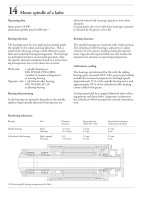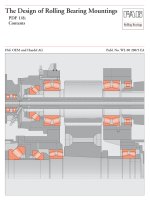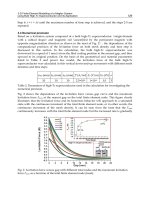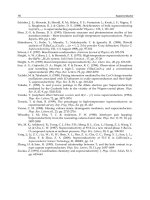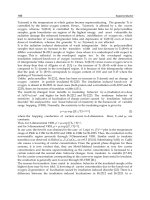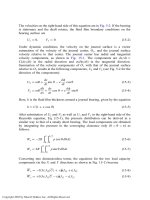The Design of Rolling Bearing Mountings Part 8 pot
Bạn đang xem bản rút gọn của tài liệu. Xem và tải ngay bản đầy đủ của tài liệu tại đây (618.1 KB, 15 trang )
65–72 Paper Machines
Modern paper machines are extensive plants which fre-
quently stretch well beyond 100 m in length and have
numerous rolls. The demand for utmost operational
reliability is priority number one when designing and
dimensioning bearing locations: if trouble arises at just
one roll the whole plant has to be shut down. For this
reason the bearings are designed for a far longer nomi-
nal life (index of dynamic stressing f
L
= 5 6) than in
other industrial equipment. A high degree of cleanli-
ness in the bearings is decisive for a long service life.
This demands utmost sealing reliability, particularly
against moisture, and design diversity based on the
type of roll in question.
Lubrication also influences the bearing life greatly. All
roll bearings in modern paper machines are connected
to an oil circulation system for operational reliability
and maintenance purposes. The bearings in the wet
end section of older paper machines are still lubricated
with grease (lower environmental temperatures).
In the dryer section, bearings for rope sheaves, spread-
er rolls and sometimes guide rolls are still lubricated
with grease.
Due to high temperatures in the area of the dryer roll,
bearing lubrication is particularly critical. Therefore
oils of the viscosity class ISO VG 220 or 320 are used.
Lightly doped mineral oils and synthetic oils are suitable
(high ageing stability), which correspond to the re-
quirements for dryer roll oils and have proven them-
selves in the field or successfully stood dynamic testing
on the FAG test rig FE8.
Lubrication can be improved considerably (increasing
the operating viscosity) by insulating the hollow jour-
nals of the dryer rolls and thus reducing the bearing
temperature.
The following examples show the structure of some
main bearing locations in the paper industry, for exam-
ple refiners, suction rolls, press rolls, dryer rolls, guide
rolls, calender thermo rolls, anti-deflection rolls and
spreader rolls.
Wet end section
large extent of water
environmental temperature < 50°C
Suction roll
Anti-deflection roll
Press section
Guide roll
Dryer
roll
Thermo roll
high humidity
environmental temperature > 100°C
(
)
(
)
Dryer section
Paper guide
roll
Finishing group
Forming section
DuoStabilizer
roll
Anti-deflection
roll
Spreader roll
Forming
roll
Spreader
roll
Spreader roll
A modern paper machine
65 Refiners
Wood chips from the wood chopper which have been
softened and steamed by water are broken down and
crushed in the refiner by means of crushing wheels ro-
tating in reverse motion with knife sections. Tempera-
tures up to 160 °C result from this process (steamed
wood chips, crushing) and can lead to increased oper-
ating temperatures in bearings depending on their
construction.
Operating data
Axial load from crushing process 400 kN;
Radial load (rotor/shaft) 15 kN per bearing;
Speed 600 min
–1
;
Temperature in locating bearing 80 °C, in floating
bearing 70 °C.
Bearing selection, dimensioning
With the high axial loads which have to be accommo-
dated, an attainable life L
hna
≥ 80,000 hours is re-
quired. A second thrust bearing is necessary since the
axial load acts mainly in the direction of the locating
bearing but can also be acting in the opposite direc-
tion. Thus the locating bearing arrangement is made up
of two symmetrically arranged spherical roller thrust
bearings FAG 29460E. For the rollers to remain undis-
turbed when the axial load is "reversed" both bearings
must be preloaded with springs (minimum load) at the
outer rings.
A spherical roller bearing FAG 23052K.MB is mount-
ed as a floating bearing and can easily accommodate
shaft deflection. Thermal length variations of the shaft
are compensated for in between bearing outer ring and
housing (sliding fit). The bearing is mounted directly
on the tapered shaft seat and fastened with a locknut
HM3052.
The floating bearing reaches a nominal life L
h
of well
over 200,000 hours. Excellent bearing lubrication is
required due to slippage hazard when loads are low
(P/C ≈ 0.02).
A nominal life of L
h
= 50,600 h is calculated for the left
locating bearing 29460E. With oil circulation lubrica-
tion, good cleanliness and a bearing temperature of
70 °C, factor a
23
is 3.2. An attainable life L
hna
=
162,000 h results from the adjusted life calculation.
The right locating bearing only has a slight axial load
(spring preload). The attainable life L
hna
is over
200,000 h for this bearing.
Machining tolerances
Floating bearing: The inner ring has circumferential
load and is attached to the tapered bearing seat of the
shaft.
Roundness tolerance IT5/2 (DIN ISO 1101);
Taper angle tolerance AT7 (DIN 7178).
Bearing seat of housing bore according to G7.
Locating bearing: For mounting reasons, both shaft and
housing washer are in sleeves. The bearing seats are
machined according to k6 and G7 for the shaft sleeves
and housing sleeves respectively.
Lubrication
A lubricating oil ISO VG 150 with EP additives is used
for locating and floating bearings.
The radial spherical roller bearing has oil circulation
lubrication with 0.8 l/min. Oil jet lubrication is pro-
vided for the spherical roller thrust bearings. This en-
sures adequate oil constantly at the highly-stressed
contact areas between roller face and lip. The oil is
supplied through the side of the bearing via the spacer
sleeve. The minimum oil flow rate for both bearings is
8 l/min (good heat dissipation from bearing). The oil
is filtered in cirulation and cooled back to a tempera-
ture of 40 °C.
Sealing
There are two labyrinths on the side of the crushing
wheel connected to one another and filled with grease
which protect the bearings from water and contamina-
tion and prevent oil escaping from the bearings. On
the outer side of the locating bearing a shaft sealing ring
prevents oil escape.
65: Refiner bearings
Locating bearingFloating bearing
66 Suction rolls
Suction rolls are found in the wire or press section of a
paper machine. They are hollow cylinders up to 10 m
in length which have several small holes all around
their circumference. Some water is removed from the
web due to the rotating roll shell and the vacuum in-
side the roll. The suction box, as interior axle, is sta-
tionary. The roll shell is driven by planet wheels in
modern paper machines.
Operating data
Roll length 7,800 mm; roll diameter 1,600 mm; rota-
tion 278 min
–1
(speed 1,400 m/min); roll weight
270 kN; wire tension 5 kN/m.
Bearing selection, dimensioning
The diameter of the suction box is decisive for the size
of the bearing. We recommend bearings with a dynam-
ic load rating as low as possible; the higher specific
bearing load reduces the danger of slippage. Self-align-
ing bearings are necessary as misalignment could arise.
Roll weight, wire tension and rotational speed are the
main criteria for dimensioning the bearings.
FAG spherical roller bearings FAG 239/850K.MB.C3
with tapered bore (K 1:12) and increased radial clear-
ance are used. The bearings are mounted directly on
the tapered shaft seats for running accuracy reasons.
The hydraulic method is applied to facilitate mount-
ing.
The locating bearing provides axial guidance for the
rolls while the floating bearing compensates for any
length variations caused by displacement of the outer
ring in the housing bore.
The nominal life for both bearings is L
h
> 100,000 h.
The attainable life reaches over 200,000 h when the
operating temperature is 60 °C and oil ISO VG 68
(viscosity ratio > 2; factor a
23
= 2.2) is used.
Machining tolerances
The inner ring has circumferential load and is attached
to the tapered bearing seat of the shaft.
Roundness tolerance IT5/2 (DIN ISO 1101); taper
angle tolerance AT7 (DIN 7178).
Housing bores according to G7 due to point load at the
outer ring.
Lubrication
The spherical roller bearings are supplied by circula-
tion lubrication with a mineral oil quantity of 8 l/min.
A mineral oil with sufficient viscosity and EP additives is
selected. Additives with good anti-corrosive properties
and water separation ability are also required. An effec-
tive lubrication is achieved with an oil supply to the
centre of the bearing.
Sealing
Any oil which escapes is thrown off via splash grooves
into oil collecting chambers and directed back. At the
roll side a baffle plate and multiple grease-filled laby-
rinth with integrated V ring prevent water penetrating
from the outside.
66: Suction roll bearings
Floating bearing Locating bearing
67 Central press rolls
The paper web runs through the press rolls on a felt
cloth and a large amount of water is pressed out of it.
Modern press sections consist of one central press roll
against which one or more (suction) press rolls are
pressed. The central press roll is solid, made of gran-
ite/steel or steel with a protective coating.
Operating data
Roll length 8,800 mm; roll diameter 1,500 mm; speed
1,450 m/min; roll weight 750 kN. Pressure by 3 rolls
at 30°, 180° and 210°; bearing temperature about
60 °C. Direct drive.
Bearing selection, dimensioning
Self-aligning spherical roller bearings of the series 231
or 232 with a very high load carrying capacity are cho-
sen due to the high radial load and the misalignment
which is possible between the bearing locations. A low
cross section height is also important for these bearings
since the height of the housing is restricted by the roll
diameter. The roll weight and the load components of
the pressure rolls yield a resulting bearing load F
r
=
300 kN.
A spherical roller bearing FAG 231/600K.MB.C3 is
mounted at every bearing location. The bearings with
tapered bore (taper 1:12) are pressed directly onto the
tapered shaft seat by means of the hydraulic method.
The floating bearing at the operator's end permits tem-
perature-depending length variations of the roll by
shifting the outer ring in the housing. The locating
bearing is at the drive end.
The nominal life calculated is L
h
> 100,000 h with a
speed of 308 min
–1
. With good lubrication (viscosity
ratio ≈ 3, basic factor a
23II
= 3) and improved cleanli-
ness (contamination factor V = 0.5) in the lubricating
gap L
hna
ӷ 100,000 h according to the adjusted rating
life calculation.
Machining tolerances
The inner ring has circumferential load and is attached
to the tapered bearing seat of the shaft.
Roundness tolerance IT5/2 (DIN ISO 1101); taper
angle tolerance AT7 (DIN 7178).
Housing bores according to G7 since there is point
load at the outer ring.
Lubrication
The spherical roller bearings are supplied with a mini-
mum oil quantity of 7 l/min by circulation lubrication.
A mineral oil of sufficient viscosity (ISO VG 100) and
EP additives is used. Additives with good anti-corrosive
properties and water separation ability are also re-
quired. An effective lubrication is achieved with an oil
supply to the centre of the bearing.
Oil returns to both sides of the bearing via oil collect-
ing pockets and connecting holes.
Sealing
Oil splash grooves in the roll journal prevent oil escap-
ing at the cover passage.
Non-rubbing and maintenance free gap-type seals pro-
tect the bearings from environmental influences.
67: Central press roll bearings
Locating bearing Floating bearing
68 Dryer rolls
The remaining water in the dryer section is evaporat-
ed. The paper runs over numerous heated dryer rolls
guided by endless dryer wires (formerly dryer felts).
The dryer rolls are steam heated (temperature depends
on the type of paper, its thickness and speed, and on
the number of dryer rolls). The high temperatures of
the heating steam transfer to the bearing seats stressing
the rolling bearings accordingly. Today, the journals
through which the steam flows are insulated in order
to keep bearing temperatures low.
Operating data
Working width 5,700 mm; roll diameter 1,800 mm;
paper speed 1,400 m/min (rotational speed 248 min
–1
);
heating temperature 165 °C (7 bar); roll weight 90 kN.
Felt pull 4.5 kN/m; wrap angle 180°; environmental
temperature under the dryer section hood approx.
95 °C; insulated journal bores.
Bearing selection
The bearing load is calculated from the roll weight, felt
pull and temporary water fill. The floating bearing is
loaded with 75 kN, the locating bearing with 83 kN
taking into account the drive force. Heating the dryer
roll leads to heat expansion which in turn leads to con-
siderable changes in length with such long rolls. Self-
aligning rolling bearings are necessary due to the mis-
alignment arising between both bearing locations.
A double-row cylindrical roller bearing of the dimen-
sion series 31 is provided as floating bearing at the
operator's end. It easily compensates for length varia-
tions in the bearing between the rolls and the inner
ring raceway. With its spherical sliding surface a plain
spherical bearing's seating ring accommodates any
alignment inaccuracy of the journal. A double-row
self-aligning cylindrical roller bearing FAG
566487K.C5 with the dimensions 200x340x112 mm
is mounted. A spherical roller bearing FAG
23140BK.MB.C4 is mounted as locating bearing on
the drive end.
Both bearings have about the same operating clearance
in order to avoid any detrimental preload during the
heating-up stage which may lead to a maximum tem-
perature difference of 50 K. The spherical roller bear-
ing has an increased radial clearance according to C4
(260 340 microns), the cylindrical roller bearing an
increased radial clearance according to C5 (275 330
microns).
Both bearings have a tapered bore (K 1:12) and are
mounted by the hydraulic method directly onto the
tapered journals.
Since the cylindrical roller bearing and the spherical
roller bearing have the same dimensions unsplit PMD
plummer block housings (FAG PMD3140AF or BF)
are applied both at the drive end and at the operator's
end.
Due to increased operating temperature, both bearings
are given special heat treatment (isotemp) and are thus
dimensionally stable up to 200 °C.
Bearing dimensioning
An attainable life L
hna
≥ 250,000 hours is required for
dryer roll bearings. Lubrication decisively influences
the adjusted rating life. Under an average operating
temperature of 100°C the operating viscosity ≈
16 mm
2
/s for a mineral oil with a nominal viscosity of
220 mm
2
/s (ISO VG 220).
The rated viscosity is determined from the speed and
the mean bearing diameter d
m
= (200 + 340)/2 =
270 mm to
1
= 25 mm
2
/s.
The viscosity ratio is then:
= /
1
= 16/25 = 0.64.
With the value K = 1 a basic factor a
23II
= 1.1 is ob-
tained for the spherical roller bearing.
The values K = 0 and a
23II
= 1.4 apply to the cylindri-
cal roller bearing.
With normal cleanliness (cleanliness factor s = 1) the
factor a
23
= a
23II
· s
1.1 for the spherical roller bearing,
1.4 for the cylindrical roller bearing.
The attainable life L
hna
= a
1
· a
23
· L
h
is therefore well
over 250,000 h for both bearings.
Machining tolerances
The inner rings have circumferential load and have a
tight fit on the tapered roll journal. The journals have
oil ducts so the bearings can be mounted and dis-
mounted by means of the hydraulic method. Round-
ness tolerance IT5/2 (DIN ISO 1101), taper angle tol-
erance AT7 (DIN 7178). Bearing seats in the housing
bore according to G7.
Lubrication
The bearing housings are connected to a central oil cir-
culation lubrication system so that heat is constantly
dissipated from the bearing. High-grade mineral oils
ISO VG 220 or 320 are used which must have a high
operating viscosity, thermal stability, good protection
against wear, good water separation ability and a high
degree of cleanliness. A minimum oil quantity of 1.6
l/min is guided directly to the centre of the bearing via
a lubricating groove and lubricating holes in the outer
ring.
The oil can be carried off at both sides of the bearing
with the central oil system. The danger of oil retention
and leakage is minimized considerably. Any contami-
nants or wear particles which might penetrate the
bearing are immediately washed out of it with this
method of lubrication.
Sealing
Gap-tape seals, which are non-rubbing and mainte-
nance-free, are provided as sealing for the journal pas-
sages. The oil is thrown off via splash grooves and oil
collecting chambers and flows back through return
holes to the two oil cavities on the housing floor. Cover
seals make the housing of the paper machine oil proof.
68: Dryer roll bearings
Locating bearing Floating bearing
69 Guide rolls
Guide rolls guide, as the name indicates, and turn the
wire and felt cloth in the wet end and dryer sections of
a paper machine. The same bearings are used for the
guide rolls in both areas. Lubrication and sealing differ,
however, depending on the place of application.
In older machines the wet end section is usually lubri-
cated with grease, and the dryer section with oil.
In modern machines both sections have oil circulation
lubrication. Due to different operating conditions
separate oil circuits are necessary for the wet end and
dryer sections.
The larger the machine the more often it is found to
be faster. For this reason the bearing inner rings are
mounted with a tapered bore directly on the tapered
roll journal.
Wet end section
Depending on the positions of the bearings in the ma-
chine they are subject to a small or large degree of
moisture. Water must not penetrate the housing par-
ticularly when machines are being high-pressure
cleaned.
Dryer section
Environmental temperatures of about 95 °C lead to
great length variations and place high demands on
lubrication. The operating temperature of the bearings
can be 115 °C.
Operating data
Useful width 8,800 mm
Roll diameter 700 mm
Paper speed 1,650 m/min (n = 750 min
–1
)
Roll weight F
G
≈ 80 kN
Paper pull 1 kN/m (tensile load F
z
≈ 9 kN)
Wrap angle 180°
Bearing temperature approx. 105 °C
Bearing selection, dimensioning
The bearings must be able to accommodate loads and
compensate for misalignment at the same time (mis-
alignment, bending). An increased radial clearance
according to C3 is necessary due to temperature differ-
ences. Spherical roller bearings FAG 22330EK.C3 are
mounted.
Bearing load:
P = (F
G
+ F
z
)/2 = (80 + 9)/2 = 44.5 kN
The diameter of the roll journal is determined by the
roll rigidity required. As a result there is a high index of
dynamic stressing f
L
corresponding to a nominal life L
h
of well over 200,000 hours. The attainable life is even
higher with such good lubrication conditions.
The housings can be in standing or suspended position
or can be laterally screwed on. They are designed for
oil circulation lubrication.
Machining tolerances
The inner rings have circumferential load and are di-
rectly fitted to the tapered roll journal. The roll journal
have oil ducts so the bearings can be mounted and dis-
mounted with the hydraulic method.
Roundness tolerance IT5/2 (DIN ISO 1101); taper
angle tolerance AT7 (DIN 7178).
Bearing seats in the housing bore according to G7.
Lubrication
In the dryer section: see example 68 (Dryer rolls) since
the bearings are connected to the oil circuit of the
dryer rolls. Minimum flow rate 0.9 l/min.
In the wet end section: see example 66 (Suction rolls)
and 67 (Central press rolls), since the bearings are con-
nected to the oil circuit of the wet section rolls.
Minimum flow rate 0.5 l/min.
Sealing
Gap-type seals, which are non-rubbing and mainte-
nance-free, prevent oil from escaping through the cov-
er passages in the dryer section.
The bearings in the wet end section must have relubri-
catable labyrinth seals to prevent water from penetrat-
ing. Remaining oil is thrown off by splash grooves into
collecting chambers and directed back. Cover seals
make the housing oilproof.
69: Guide roll bearings (dryer section)
Locating bearingFloating bearing
70 Calender thermo rolls
The paper passes through the so-called calender stack
after leaving the dryer section. Soft calenders smooth
the surface of the paper thus improving its printability.
The calender consists of two pairs of rolls. One calend-
er roll (steel) lies above a counter roll, another below
one. The counter roll is the so-called anti-deflection
roll (elastic material). Soft calender rolls can be heated
by water, steam, or oil. The gap or the "nip" pressure
depends on the type of paper.
Operating data
Useful width approx. 7 m
Rotation 350 min
–1
(speed 1,100 m/min)
Heated by oil at 200 250 °C
Insulated roll journal
Operating temperature at bearing inner ring 130 °C.
Bearing selection, dimensioning
The radial bearing load depends on the application of
the calender roll as lower or upper roll, on the weight
F
G
and the variable pressure load with percentage of
time.
P
1
= F
G
+ F
nip min
= 600 kN
P
2
= F
G
+ F
nip med
= 990 kN
P
3
= F
G
+ F
nip max
= 1,260 kN
P
4
= F
G
– F
nip min
= 60 kN
P
5
= F
G
– F
nip med
= 390 kN
P
6
= F
G
– F
nip max
= 720 kN
Percentages of time: P
1
, P
4
: 10 % each
P
2
, P
3
, P
5
, P
6
: 20 % each
The sum of the roll weight and the nip load acts for
the application as bottom roll whereas their difference
acts for the application as top roll.
Taking the maximum load for designing the bearing
would lead to overdimensioning (equivalent dynamic
load P < 0.02 · dynamic load rating C) in the case of
application in the top roll. Slippage may occur with
such a low load which in turn can lead to bearing dam-
age when lubrication is inadequate. In order to avoid
this problem, smaller bearings with a smaller dynamic
load rating C should be selected so that P/C > 0.02.
The risk of breaking through the lubricating film
drops with the smaller roller mass.
Requirements with respect to load carrying capacity
and self-alignment are met by spherical roller bearings.
The cross section height of the bearing is limited by
the diameter of the roll journal and roll shell. The
relatively wide spherical roller bearings FAG
231/560AK.MB.C4.T52BW are mounted.
The nominal life L
h
= 83,000 h with given loads and
percentages of time.
With a lubricating oil ISO VG 220 the viscosity ratio
is = 0.71 under an operating temperature of 130 °C.
An attainable life L
hna
> 100,000 h is obtained with the
adjusted rating life calculation (where f
s*
> 12; a
23II
=
1.2; V = 0.5; s = 1.6).
The increased radial clearance C4 is required due to
the danger of detrimental radial preload in the bearing
during the heating up phase when the temperature
difference is great. With a speed index n · d
m
=
224,000 min
–1
· mm we recommend bearings with
increased running accuracy according to specification
T52BW.
Machining tolerances
The inner rings have circumferential load and are di-
rectly fitted on the tapered roll journal. The roll jour-
nals have oil ducts so that the hydraulic method can be
applied for mounting and dismounting the bearings.
Roundness tolerance IT5/2 (DIN ISO 1101), taper
angle tolerance AT7 (DIN 7178).
Bearing seats in the housing boring according to F7.
Lubrication
Oil circulation lubrication with a synthetic oil ISO VG
220, suitable in quality, which has stood dynamic test-
ing on the FAG test rig FE8.
By supplying a large amount of oil to the centre of the
bearing (minimum flow rate 12 l/min) heat dissipation
is achieved as well as a low thermal stress of the oil.
Any contaminants or wear particles are washed out of
the bearing. Oil returns at both sides of the bearing via
oil collecting pockets and connecting holes.
Sealing
Angle rings at the roll side prevent direct oil escape at
the cover holes. Remaining oil is thrown off by splash
grooves into collecting chambers and directed back.
Cover seals make the housing oilproof.
70: Calender thermo roll bearings
Floating bearing Locating bearing
71 Anti-deflection rolls
Anti-deflection rolls are found in both the press sec-
tion and in calenders. They provide for an even paper
thickness across the web and a consistently high paper
quality. The drive is at the locating bearing end. Its
power is transmitted via gearing and the hypoid teeth
coupling to the roll shell.
The adjustment roll is pressed against the mating roll
(calender roll) under very high pressure. As a result the
mating roll is bent and the form of the roll shell
changed. The shell of the adjustment roll must adjust
to this form.
The anti-deflection roll consists of a stationary axle
and a rotating roll shell. Control elements which can
be pressure-balanced separately are provided on the
axle. They support the roll shell hydrostatically and
effect its adjustment. The roll shell is shaped like the
bent mating roll by the changing pressure giving the
paper an even thickness.
Operating data
Roll length 9,300 mm; roll diameter 1,025 mm; roll
weight 610 kN; shell weight 210 kN; pressure 700 kN;
circumferential velocity 1,500 m/min (n = 470 min
–1
);
bearing temperature 55 °C.
Bearing selection, dimensioning
A service life of > 100,000 h is required. The bearing
only has a guidance function when in operation (with
pressure and closed gap).
Spherical roller bearings FAG 23096MB.T52BW
(dynamic load rating C = 3,800 kN) are used.
Due to the danger of slippage bearings of the series
239 with a low load rating should be selected.
The bearings are produced with a reduced radial run-
out (specification T52BW), since running inaccuracy
of the rotating roll shell influences the quality of the
paper web.
Machine tolerances
Bearing seats on the axle according to f6 due to point
load for the inner rings.
The outer rings have circumferential load and a tight fit;
the bearing seats in the housings are machined to P6.
Lubrication
When dynamic misalignment and/or slippage may
occur, a very good lubrication system must always pro-
vide a load-carrying lubricating film. The bearings are
supplied with the lubricating oil used for the hydraulic
system (ISO VG 150 with EP additives). The oil is fed
laterally to the bearings via holes. In new designs and
particularly with heated rolls, the lubricating oil is fed
via lubricating holes in the inner ring directly to the
bearing contact areas.
The deep groove ball bearings of the transmission ar-
ranged at the locating bearing side are supplied with oil
via a separate oil circuit.
Sealing
The bearings are sealed externally with a shaft seal. To
the roll side a baffle plate provides for an oil reservoir
in the bearing area.
71: Anti-deflection roll bearings
Floating bearing Locating bearing
72 Spreader rolls
Paper webs transported in lengthwise direction tend to
creasing. Spreader rolls stretch or expand in cross di-
rection the webs running over them. They flatten
creases and any middle or end parts of the web which
are loose. Spreader rolls consist of a stationary axle
which is bent symmetric to its longitudinal axis, and
around which the roll shell rotates. Tube-shaped sec-
tions make up the roll shell and are arranged to rotate
freely and have angular freedom. The sections adjust to
one another in such a way that the bending form of
the axle is reflected on the shell surface. Depending on
the case of application – wet end section, dryer section,
or subsequent processing – the sections are made of
stainless steel or provided with a flexible coating (e.g.
rubber).
Operating data
Roll length 8,300 mm, consisting of 22 sections;
weight/section plus wire or paper web pull at 30° wrap
angle 2 kN/m; a radial load of just 0.5 kN per bearing
results therefrom.
Rotation of roll shell 1,160 min
–1
.
Operating temperature in the wet end section 40 °C;
in the dryer section and in subsequent processing with
infrared drying temperatures can reach 120 °C.
Bearing selection, dimensioning
With rotating outer ring, extremely smooth running is
required from the bearings since the sections in the wet
end section and in the dryer section or subsequent pro-
cessing are only driven by the wire tension and the
paper web respectively.
High operational reliability is also necessary since the
failure of one bearing alone means that the whole
spreader roll has to be dismounted.
FAG 61936.C3 deep groove ball bearings are selected.
The increased radial clearance C3 permits easy adjust-
ment of the sections. With the low load, the bearings
have a nominal life L
h
of well over 100,000 hours.
Machining tolerances
As the outer ring of the bearing rotates with the roll
shell it is given a tight fit with M6 tolerance and is se-
cured axially by a snap ring.
The inner ring has point load and is fitted to the shaft
sleeve with h6. Due to the bent roll axle and for assem-
bly reasons the sleeve is loosely fitted and axially at-
tached with a screw.
Lubrication
The bearings are greased for life, i.e. no relubrication is
provided for. The selection and filling quantity of lu-
bricating grease is determined by the demand for
smooth running as well as a service life of up to five
years (8,000 operating hours per year). Low-friction
greases (e.g. greases of class LG10 for the wet end sec-
tion) are advantageous with high speeds and low loads.
Sealing
Non-rubbing dust shields are used for sealing due to
the smooth running required. They are stuck to the
bearing outer ring on both sides so the base oil centri-
fuged from the lubricating grease cannot escape. Round
cord seals also provide for oil tightness.
72 Spreader roll bearings
73 Run wheel of a material ropeway
Operating data
Speed n = 270 min
–1
; radial load F
r
= 8 kN. Thrust
loads as guidance loads only, considered by 20 % of
the radial load: K
a
= 1.6 kN.
Bearing selection
Each run wheel is supported by two tapered roller
bearings FAG 30306A. The bearings are assembled in
O arrangement which provides for a wider bearing
spread than an X arrangement. The wider the spread,
the lower the additional bearing load from thrust load
K
a
.
Bearing dimensioning
As thrust load K
a
acts at the wheel circumference, it
generates radial reaction forces at the bearing loca-
tions.
Thus,
F
rA
/Y = 6.1/1.9 = 3.2; F
rB
/Y = 1.9/1.9 = 1 and
consequently F
rA
/Y > F
rB
/Y
The second condition proven is
K
a
> 0.5 · (F
rA
/Y – F
rB
/Y) = 0.5 (3.2 – 1) = 1.1
For calculation of bearing A the following thrust load
F
aA
must, therefore, be taken into account:
F
aA
= K
a
+ 0.5 · F
rA
/Y = 1.6 + 0.5 · 1.9/1.9 = 2.1 kN
Consequently, the equivalent dynamic load P
A
of bear-
ing A is:
P
A
= 0.4 · F
rA
+ Y F
a
= 0.4 · 6.1 + 1.9 · 2.1 = 6.45 kN
With this load, the indicated dynamic load rating and
the speed factor f
n
= 0.534 (n = 270 min
–1
) the index of
dynamic stressing.
f
L
= C/P
A
· f
n
= 60/6.45 · 0.534 = 4.97
This value corresponds to a nominal rating life of more
than 100,000 hours. Since this calculation is based on
the most unfavourable load conditions, the thrust load
acting constantly at its maximum and only in one di-
rection, the bearing is adequately dimensioned with re-
gard to fatigue life. The service life will probably be ter-
minated by wear, especially under adverse operating
conditions (high humidity, heavy contamination).
The load carrying capacity of bearing B does not need
to be checked since its loading is much less than that
of bearing A.
Machining tolerances
The run wheel mounting is a so-called hub mounting,
i.e. the run wheel, with the two cups, rotates about a
stationary shaft. The cups carry circumferential load
and are thus tight-fitted. The shaft is machined to h6,
the hub bore to M6.
Lubrication, sealing
The bearings and the free spaces have to be filled dur-
ing mounting with grease, e. g. FAG rolling bearing
grease Arcanol L186V. The grease filling will last for
approximately one year.
In the example shown, the bearings are sealed by
spring steel seals (Nilos rings).
Bearing A:
F
rA
= F
r
/2 + K
a
· (D/2)/l = 4 + 1.6 · 125/95 = 6.1 kN
The thrust load K
a
= 1.6 kN acts toward bearing A.
Bearing B:
F
rB
= F
r
/2 – K
a
· (D/2)/l = 4 – 1.6 · 125/95 = 1.9 kN
Radial loads acting on a shaft supported on two ta-
pered roller bearings generate axial reaction loads
which have to be considered in the calculation of the
equivalent dynamic load. These internal loads together
with the external thrust loads should, therefore, be tak-
en into account for life calculation (see FAG catalogue
WL 41 520, chapter "Tapered roller bearings").
Data for tapered roller bearings FAG 30306A (desig-
nation to DIN ISO 355: T2FB030):
dynamic load rating C = 60 kN,
Thrust factor Y = Y
A
= Y
B
= 1.9.
73: Run wheel of a material ropeway
Rope
